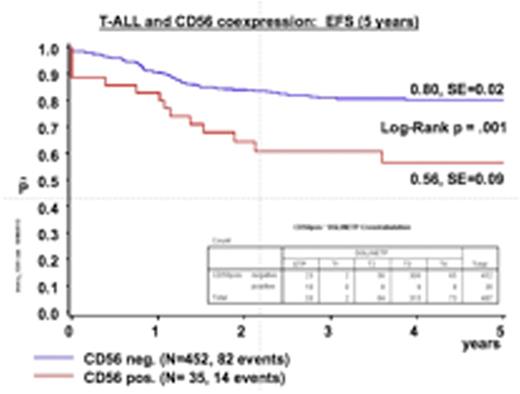Abstract
Purpose: To investigate the prognostic impact of the coexpression of the natural killer cell marker CD56 / neural-cell adhesion molecule NCAM and to compare it to the immunophenotype subgroups according to the EGIL/WHO 2008 classification and to the early T-cell precursor (ETP) subtype for patients with T-ALL treated in the ALL-BFM 2000 protocol.
Patients and Methods: The immunophenotype of 493 children with T-ALL was analyzed centrally at diagnosis with a four-color antibody panel consisting of 28 different antibodies for the detection of antigen expression in the cytoplasm and on the surface of the blast cell population. The frequency of immunophenotypic subtypes and their correlation with event-free survival (EFS) and cumulative incidence of relapse (CIR) were investigated.
Results: The frequencies of T-ALL subtypes according to the EGIL/WHO classification were 0.4% for pro-T-ALL, 19.9% for pre-T-ALL, 64.7% for cortical T-ALL and 15% for mature T-ALL. The frequency of the ETP subtype according to the ETP-Score published by Inukai T. et al. (Br J Haematol. 2012) was 6.7% (surface CD3 negative) or 7.5% (with surface CD3 positivity) of all the patients with T-ALL. This is a lower frequency compared to the findings in the St. Jude and AIEOP patients published by Coustan-Smith E. et al. (Lancet Oncology 2009), but similar to what has been reported for the Tokyo Children's Cancer Study Group Study L99-15 by Inukai T. et al. (Br J Haematol. 2012). Coexpression of CD56 was detected in 7.2% of all T-ALL patients. The percentage of ETP in the CD56+ T-ALL cohort was 4-fold increased (30%) as compared to all T-ALL patients (7.2%).
The 5-year EFS rates for the EGIL/WHO subgroups pre-T-ALL (n=57), cortical-T-ALL (n=310), and mature T-ALL (n=66) were not statistically different (0.72, SE=0.06, 0.83, SE=0.02, and 0.74, SE=0.06, respectively, Fig. 1). Also the 5-year EFS for the ETP (n=23) did not statistically differ from the non-ETP T-ALL cohort (Fig.1). By contrast, patients with CD56 coexpression (n=35) had a significantly lower 5-year EFS and a higher CIR at 5 years than patients without CD56-expression (EFS: 0.56, SE=0.09 vs. 0.80, SE=0.02, log-rank p = 0.001; CIR: 0.25, SE=0.8 vs. 0.14, SE=0.02, p(Gray) = 0.08), (Fig. 2). In the multivariate analysis, considering other risk parameters like age older than 10 years, WBC greater than 100,000 and prednisone response, CD56 coexpression was an independent prognostic marker for 5-year-EFS with a hazard ratio (HR) of 2.50 (p = 0.002). CD56 coexpression lost significant prognostic impact with the addition of the MRD risk groups to the multivariate model (HR=1.45, n.s.).
Conclusion: In the ALL-BFM 2000 trial the prognostic significance of the ETP-phenotype, which has been previously demonstrated as being prognostically unfavorable in several ALL clinical trials, could not be confirmed. The CD56-coexpression, although not superior to the MRD risk assignment, warrants further investigation as an additional independent prognostic indicator at diagnosis for unfavorable clinical outcome in childhood T-ALL.
Moricke:JazzPharma: Honoraria, Other: financial support of travel costs.
Author notes
Asterisk with author names denotes non-ASH members.



This feature is available to Subscribers Only
Sign In or Create an Account Close Modal